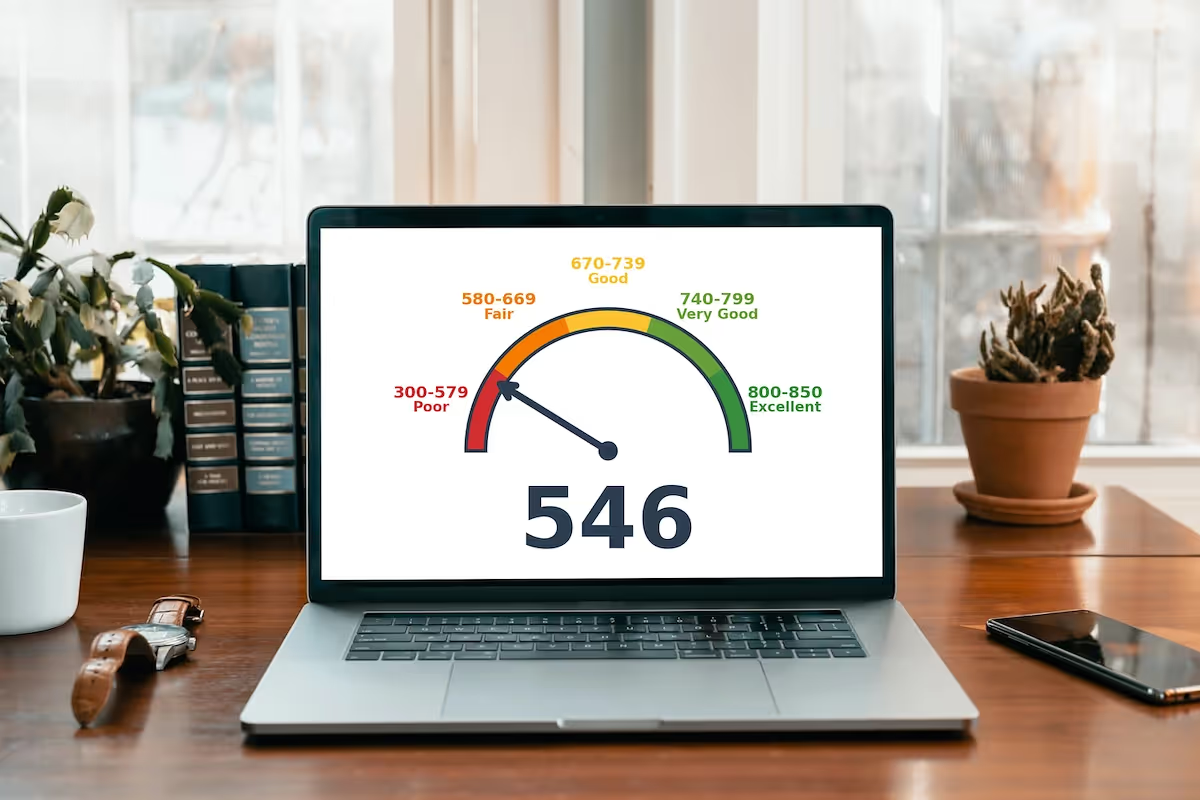
Kudos has partnered with CardRatings and Red Ventures for our coverage of credit card products. Kudos, CardRatings, and Red Ventures may receive a commission from card issuers. Kudos may receive commission from card issuers. Some of the card offers that appear on Kudos are from advertisers and may impact how and where card products appear on the site. Kudos tries to include as many card companies and offers as we are aware of, including offers from issuers that don't pay us, but we may not cover all card companies or all available card offers. You don't have to use our links, but we're grateful when you do!
546 Credit score: What You Need to Know in 2025
July 1, 2025


TL;DR
A 546 credit score is a foundational step on your financial journey, offering a clear path for growth. According to the FICO model, this score falls into the "Poor" credit range, highlighting specific areas to focus on for improvement.
What Does a 546 Credit Score Mean?
A credit score of 546 falls into the "poor" range on the FICO scale, which runs from 300 to 850. Lenders generally see scores in this category as high-risk, which can significantly impact your financial life. You may find it difficult to get approved for new credit cards or loans. If you are approved, you'll likely face higher interest rates and less favorable terms, making borrowing more expensive.
While this score presents immediate hurdles, it's not a permanent financial sentence. Your score is a snapshot in time, not a life-long label. It serves as a baseline from which you can begin to build a stronger credit profile. Moving forward, focusing on positive financial habits can pave the way for better opportunities and greater stability.
Who Has a 546 Credit Score?
A 546 credit score is significantly below the average for any age group. Data on average credit scores by generation from 2023 shows a clear trend where scores improve with age:
- Generation Z (ages 18-26): 680
- Millennials (ages 27-42): 690
- Generation X (ages 43-58): 709
- Baby Boomers (ages 59-77): 745
- Silent Generation (ages 78+): 760
Credit Cards With a 546 Credit Score
A credit score of 546 falls into the "poor" credit range, which can significantly impact your ability to qualify for a credit card. Most lenders view this score as high-risk, meaning you'll likely face rejections for standard unsecured cards that offer premium rewards and low interest rates. Your options will primarily be limited to secured credit cards, which require a cash deposit, or unsecured cards designed for building credit, which often come with higher fees and interest rates.
Kudos uses AI-powered tools to help you find the right card by analyzing your financial goals and spending habits. These tools provide personalized recommendations from a database of nearly 3,000 cards and offer insights into how a new card might impact your credit.
Auto Loans and a 546 Credit Score
A 546 credit score places you in the subprime borrower category, which means you will face significantly higher interest rates, according to a recent auto loan analysis. Lenders view this score as higher risk, making it more challenging and expensive to secure financing for a vehicle.
- Super-prime (781-850): 5.25% for new cars, 7.13% for used cars
- Prime (661-780): 6.87% for new cars, 9.36% for used cars
- Non-prime (601-660): 9.83% for new cars, 13.92% for used cars
- Subprime (501-600): 13.18% for new cars, 18.86% for used cars
- Deep subprime (300-500): 15.77% for new cars, 21.55% for used cars
Mortgages at a 546 Credit Score
A 546 credit score narrows your mortgage options, but doesn't eliminate them. Your most viable path is an FHA loan, which has specific requirements like a 10% down payment for scores below 580. Conventional loans are generally unavailable, as they typically require a score of at least 620. While some government-backed loans have no official minimum, finding a lender to approve a 546 score is rare.
Securing a loan with this score means facing less favorable terms. Lenders will charge higher interest rates and fees to offset their risk. You can also expect stricter underwriting, where your entire financial profile is scrutinized more heavily. This results in a higher monthly payment and overall loan cost.
What's in a Credit Score?
Figuring out what goes into your credit score can feel like trying to solve a complex puzzle, but it generally boils down to a handful of key financial habits. Here are the most common factors that determine your score:
- Your history of making payments on time is the most significant factor.
- The amount of your available credit that you're currently using, known as your credit utilization ratio, plays a major role.
- How long you've had your credit accounts open contributes to the length of your credit history.
- Lenders like to see that you can responsibly manage a variety of credit types, such as credit cards and loans.
- Opening several new credit accounts in a short period can be seen as a risk and may temporarily lower your score.
How to Improve Your 546 Credit Score
Improving your credit score is always possible through consistent, positive financial behaviors, and a 546 score is a solid starting point for building a healthier profile. There are several proven methods you can use to begin the process.
- Establish automatic bill payments. Since payment history is the most significant factor in your score, setting up automatic payments ensures you never miss a due date. This prevents late payments from further damaging your credit and starts building a positive track record.
- Reduce your credit utilization ratio. This ratio is the second most important scoring factor, and keeping it below 30% is crucial. Paying down balances shows lenders you can manage debt responsibly and aren't over-reliant on credit.
- Apply for a secured credit card. A secured card is an excellent tool for someone with a 546 score to demonstrate responsible credit use. Because the card requires a security deposit and reports to the major bureaus, it allows you to build a positive payment history.
- Monitor your credit reports. Regularly checking your reports from Experian, TransUnion, and Equifax helps you identify and dispute inaccuracies that could be unfairly lowering your score. Correcting errors can provide a direct and sometimes immediate boost to your creditworthiness.
To find the right credit-building products and maximize rewards as you improve your score, let Kudos help you make smarter financial decisions.
Unlock your extra benefits when you become a Kudos member

Turn your online shopping into even more rewards

Join over 400,000 members simplifying their finances

Editorial Disclosure: Opinions expressed here are those of Kudos alone, not those of any bank, credit card issuer, hotel, airline, or other entity. This content has not been reviewed, approved or otherwise endorsed by any of the entities included within the post.



































.webp)



.webp)

.webp)


